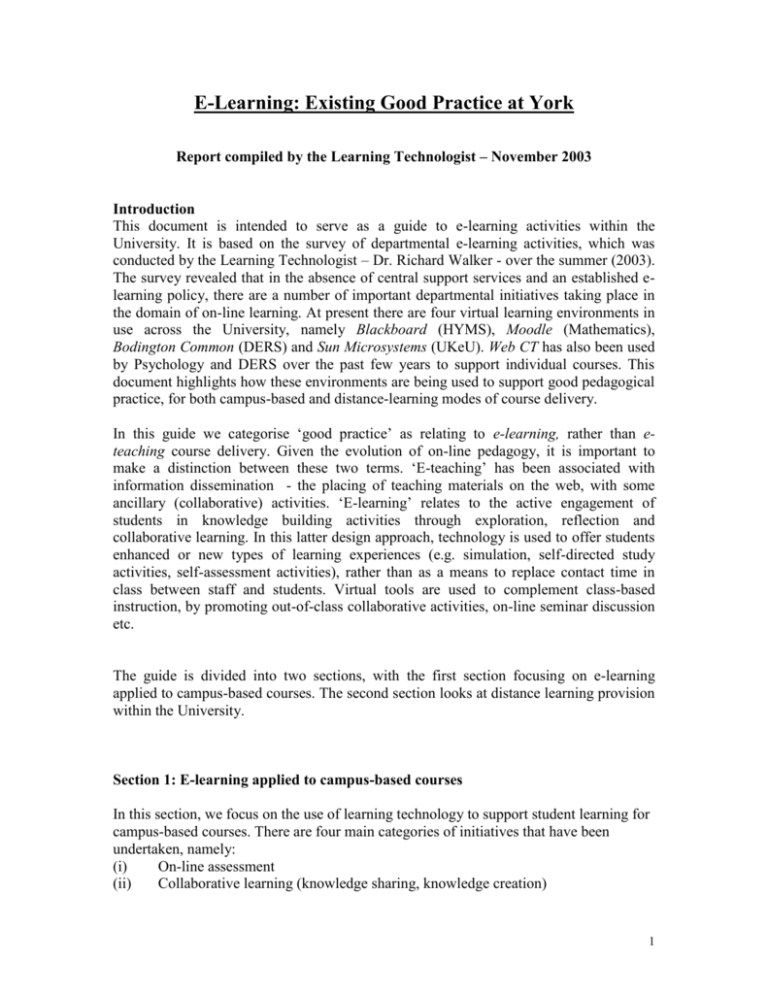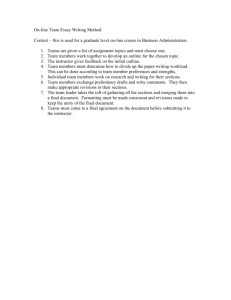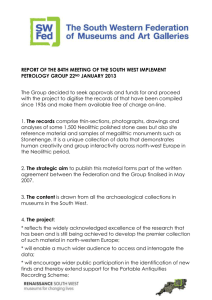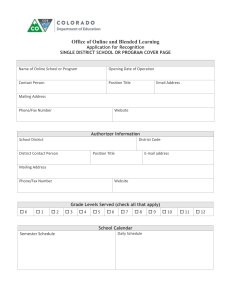E-Learning: Existing good practice at York
advertisement

E-Learning: Existing Good Practice at York Report compiled by the Learning Technologist – November 2003 Introduction This document is intended to serve as a guide to e-learning activities within the University. It is based on the survey of departmental e-learning activities, which was conducted by the Learning Technologist – Dr. Richard Walker - over the summer (2003). The survey revealed that in the absence of central support services and an established elearning policy, there are a number of important departmental initiatives taking place in the domain of on-line learning. At present there are four virtual learning environments in use across the University, namely Blackboard (HYMS), Moodle (Mathematics), Bodington Common (DERS) and Sun Microsystems (UKeU). Web CT has also been used by Psychology and DERS over the past few years to support individual courses. This document highlights how these environments are being used to support good pedagogical practice, for both campus-based and distance-learning modes of course delivery. In this guide we categorise ‘good practice’ as relating to e-learning, rather than eteaching course delivery. Given the evolution of on-line pedagogy, it is important to make a distinction between these two terms. ‘E-teaching’ has been associated with information dissemination - the placing of teaching materials on the web, with some ancillary (collaborative) activities. ‘E-learning’ relates to the active engagement of students in knowledge building activities through exploration, reflection and collaborative learning. In this latter design approach, technology is used to offer students enhanced or new types of learning experiences (e.g. simulation, self-directed study activities, self-assessment activities), rather than as a means to replace contact time in class between staff and students. Virtual tools are used to complement class-based instruction, by promoting out-of-class collaborative activities, on-line seminar discussion etc. The guide is divided into two sections, with the first section focusing on e-learning applied to campus-based courses. The second section looks at distance learning provision within the University. Section 1: E-learning applied to campus-based courses In this section, we focus on the use of learning technology to support student learning for campus-based courses. There are four main categories of initiatives that have been undertaken, namely: (i) On-line assessment (ii) Collaborative learning (knowledge sharing, knowledge creation) 1 (iii) (iv) Learning objects (supporting self-directed learning pathways) Teaching objects (interactive instructional packages) Section 2: Distance learning provision In this section, we document the existing distance-learning courses run by the University, which are supported by virtual learning environments. (i) (ii) (iii) DERS (Health Economics for Health Care Professionals) – supported by Bodington Common Electronics (Project Management) – supported by LearnLinc UKeU/Social Policy (Public Policy & Management) – supported by Sun Microsystems 2 Section 1: E-learning applied to campus-based courses There are a number of e-learning initiatives directed towards the enhancement of teaching and learning for campus-based courses. These initiatives may be placed into the following categories: (i) (ii) (iii) (iv) On-line assessment Collaborative learning (knowledge sharing, knowledge creation) Learning objects (supporting self-directed learning pathways) Teaching objects (interactive instructional packages) (i) On-line assessment Course illustration Mathematics: Assessment in Mathematics (AiM) system Led by Gustav Delius Introduced in Autumn 2003 The Mathematics Department currently uses Moodle, an open-source virtual learning environment1), to host the Assessment in Mathematics (AiM) system. Students log on to Moodle, where they are able to access AiM, as well as view course materials and use collaborative tools for discussion purposes. Rationale for the introduction of AiM Students learn about mathematics by practising. Prior to the introduction of this system, students tackled problems that were marked by Graduate Teaching Assistants over a twoweek period after submission of the work. There was a significant delay in feeding back to students comments and grades on their work. With the rise in student numbers, the cost and time involved in marking work have increased, exerting a greater pressure on graduate teaching / assessment resources. AiM offers students immediate feedback on their work (for each part of a problem, not just the final solution) and is useful in generating marks for student work. Administrative needs are a driver for the introduction of this tool, but there are a number of related benefits, notably better communication with students. 1 Moodle (http://moodle.org) is a software package for producing course sites and web sites. We might best refer to it as a virtual learning environment (VLE) - a computer system which supports on-line learning, allowing students to interact with learning materials, fellow students and instructors. Moodle positively encourages collaboration and critical reflection processes amongst students, offering a flexible array of tools for these purposes. These include forums, journals, quizzes, surveys, chat and workshops. Students may also include their profile picture in a chat window, adding a personal touch to on-line communication. 3 The AiM system deals with computer algebra and grades problems automatically. This is a necessary innovation, given that answers to mathematical problems do not fit a multiple-choice format. One consequence of the launch of this system will be the freeing up of GTA time. Graduates can be used for seminar teaching, directing small groups for weekly sessions. The reduction of graduate marking time will directly benefit students, with graduates devoting more time to teaching and working with students. It will also enable staff to increase the percentage of course assignments that students undertake. The system eliminates the risk of students copying off each other by generating a random set of problems for each student. How AiM works AiM is a web server for automatically administering graded tests and homework with mathematical content. The two distinguishing features of AiM are its use of Maple for performing computations and visualisation of mathematical formulas; and its facilities for giving partial credit. The use of Maple is ideally suited for questions that require symbolic answers and whose verification involves mathematical operations. AiM has several different mechanisms for giving partial credits. One of them is automatic, applicable to any question, and requires no special effort on the teacher’s behalf. The other two are more flexible, more questionspecific and require more effort. The teacher uses a web interface to type in a question definition, which is a text file that uses a simple flag-based syntax to describe question statements, grade student answers, generate model solutions etc.. Question definitions are compiled and added to a question database from which the actual tests are built. After entering an answer, the student presses a button to record and display it in a clear format. If the student enters a wrong answer, s/he is penalised and is asked to redo the question. Once the student gets the correct answer, a model solution is displayed. An important feature of AiM is its ability to give not only grades, but also partial credits. Several methods for doing this may be implemented, such as: Penalty for wrong answer. Students know immediately if they made a mistake and have a chance to correct it. They don’t have to wait for days, as with traditional paper homeworks. Custom grading procedure written by the teacher. It accepts the student’s answer as an argument and returns either true (meaning correct answer) or false (meaning incorrect answer) or else a number between 0 and 1 which represents the student’s grade on that question. More sophisticated grading procedures actually warn the student and give hints depending on the form of the answer. 4 Summary of related departmental activities on assessment Prof. John Holman (Chemistry) has developed, in collaboration with Leeds University, self-assessment activities for a thermodynamics unit. (ii) Collaborative learning (knowledge sharing, knowledge creation) Programme illustration HYMS: Medical curriculum, supported by Blackboard Learning System Led by Jean McKendree and Jim Kerslake Launched in Autumn 2003 Rationale for the use of the Blackboard Learning System HYMS uses Blackboard Learning System - Basic Edition (Release 6) – to support student access to learning resources, announcements about the course (reminders about due task, timetable / room changes etc.) and on-line discussions with other students and staff. 140 students are enrolled and have user accounts. How Blackboard supports collaborative learning Students are allocated to one of 16 Problem Based Learning (PBL) groups. Each group has a dedicated discussion board and file exchange area. Students begin each module by logging on to the case histories of the HYMS ‘virtual patients’. They become available, one-by-one, as students progress through the course. Participants read through the case notes and then brainstorm the key issues of the case, defining the learning objectives for the module. Each PBL group has a facilitator / tutor allocated to them, who supports their learning and offers feedback where necessary. The learning objectives provide the framework for self-directed learning activities, which lead up to the next peer group session, which is conducted face-to-face on campus. Students are encouraged to use the group discussion lists to discuss their learning objectives, and they are able to exchange files (PPT presentations etc.) via the group working space. A whiteboard for graphical illustrations may also be used at a later date. Course illustration Psychology: 3rd year u/g Organisational Psychology module, supported by Web CT Led by Annie Trapp (Psychology LTSN) Conducted over the last 3-4 academic years. Not running this academic year 5 Rationale for the introduction of on-line seminar discussion This 3rd year module, conducted over ten weeks, attracted large numbers of students in past years – around 30+ participants. Participants were expected to attend a two-hour seminar each week. Students were also expected to go through the targeted reading before each class session, ready to engage in discussion when they arrived at the seminar. However, in previous courses students did not often undertake adequate preparation and the size of the class limited the scope for effective ideas sharing and debate. This prompted the decision to divide up the class into small groups, and to assign groups with discussion tasks to be completed on-line, as preparation for the weekly seminar class. How Web CT was used Students logged on to the Web CT course environment to access course information, reading lists and discussion questions for the out-of-class phase of learning. Each group was assigned a discussion space (forum), where they could discuss the task that they had been assigned, posting their agreed response prior to the weekly seminar session. The technology thus served as a ‘forcing’ mechanism, ensuring that the preparatory work was visible and that each group was accountable for a particular problem. In the seminar session, the instructor could draw on these responses, adding her own thoughts to the discussion. At the end of the seminar, other groups could give their own feedback on the assigned task and the response that had been posted on-line. The on-line preparatory phase helped to free-up time in class, enabling the class to focus on case scenarios where the reading was applied to real-life problems. Each group was given a scenario in class to focus on, and students were expected to arrive at a solution and present a report, which would be posted on-line at an agreed time. The scenario could not be attempted without completing the reading activities first. The course instructor adopted the role of facilitator for the group work, supporting the discussion process. One of the key benefits of this approach was that students managed their own coursework, working collaboratively in the performance of the activities. In completing the work, they developed discussion notes for each topic of the course, supporting the lecture notes they received in class. Group members were also able to refer to the log from the discussion board for additional notes. Summary of related departmental activities for collaborative learning Dr. K. Davies (English) has introduced an email discussion list for the 18th Century course. The course focuses on one enormous novel (Clarissa -1500 pages), which all students have to read. Support and discussion on the novel are conducted via circular email discussion, which is monitored by the course convenor. Individual staff innovations in the History Department have included virtual seminar sessions. PEP has experimented with on-line group work - posting assignments and receiving feedback on-line. Women’s Studies has one course (MA on Literature and Cultural Studies) in which Yahoo discussion lists are used. Students are encouraged to design their own web pages and submit electronic assignments. 6 (iii) Learning objects (supporting self-directed learning pathways) Course illustration Health Sciences: Critical Care Simulation Scenarios (Shock Skills) Led by Alison Foster, Ian Cole & Carl Thompson Status: Under development Rationale for the development of the simulation software The project involves the development of software to provide a computer based simulation exercise for nursing students. The exercise will involve clinical scenarios to enhance and develop key transferable critical care skills and knowledge. The aim of this programme is to develop and test students’ judgements on clinical shock. The project will also serve as a pilot for assessing the feasibility of using computer scenarios as the basis for analytical exploration of clinical judgements and decisions by nurses. This is a major research theme within the Department, which is currently supported by NHS R&D and the MRC. How the software will work To view the scenarios and data collection forms, point your web browser to http://www.york.ac.uk/res/dec/shock/ The web-based software incorporating the data capture forms has gone on-line, the online scenarios have been generated and are in place, the database for storing responses established and linked, and piloting of the software completed. The development of the software package is almost complete, and will include short video clips demonstrating airway management techniques and cannulation. Summary of related departmental activities on learning objects Biology uses a number of computer packages (maths) and simulation programmes (DNA, population genetics), which are available on the web. Economics uses computer programmes for statistics and econometrics. The research methods module for the BAES programme (Educational Studies) is offered on-line, which includes module outlines, resources, handouts and activities which are placed on the course web-site. Electronics has introduced the Transmath package to support first year students for self-directed learning (on-line maths tests using randomised problems). Environment has introduced an interactive soils software package. Language and Linguistics has introduced a computer programme on first language acquisition (child utterances). Music has set up an electronic music studio resource on the internet for remote access. Social Work may introduce an e-learning package developed by Prof. Ian Shaw at Cardiff, to be introduced in HTML format (converted from CD ROM) for the undergraduate degree. 7 (iv) Teaching objects (interactive instructional packages) Course illustration Computer Science: Interactive teaching materials – on-line lectures (Digital Circuit Design) Led by Ian Benest Rationale for the development of the interactive teaching materials The project involves the development of software to provide students with a ‘one-stop’ access to teaching materials, which are presented in an integrated format using multimedia, with navigational dynamics also included. If the learning process is to be enhanced, then information technology must be used to provide students with a presentation that is superior to that available from books. For example, a book describing how an electronic circuit provides its function is a poor means of conveying that information. This is particularly true when the textual description is over the page from the diagram and it refers to each transistor element that must be visually found in the diagram. On-line, the user can see the diagram all the time, have each element identified (with an arrow for example) and an accompanying audio narrative, which will focus on the textual description. How the ‘on-line lecture’ works An ‘on-line lecture’ is the mimicry of a live lecture, with an audio narrative synchronised with events such as slide changes, revelation of information, animation (showing, for example, data-flow), the narrated construction of a diagram, and so on. The lecture is designed using hypermedia and aims to mimic the features of a real book, while exploiting the possibilities that information technology can provide. So if lectures are also available on-line, students can view them prior to the live event and view then again when some aspect of the lecture was missed or was found to be too difficult to absorb at the time. Summary of related departmental activities on teaching objects Archaeology has made a big investment in terms of the creation of web-based teaching resources. The department has served as a partner in national consortia for the development of teaching materials. In Computer Science, staff use software to simulate hardware for teaching purposes. Ken Todd (Electronics) has developed a web / CD resource to support maths teaching. Computer packages are used to assist students prior to attending lab. sessions ( a comprehensive range of pre- and post laboratory Authorware packages). Physics uses a number of computer packages - an algebra system, the Transmath maths package and StoMP (Software Teaching of Modular Physics). 8 Section 2: Distance-learning provision In this section, we document the existing distance-learning courses run by the University, which are supported by virtual learning environments. (i) (ii) (iii) (i) DERS (Health Economics for Health Care Professionals) – supported by Bodington Common Electronics (Project Management) – supported by LearnLinc UkeU/Social Policy (Public Policy & Management) – supported by Sun Microsystems DERS and Bodington Common DERS: Bodington Common VLE (Health Economics for Health Care Professionals) Led by Martin Forster The Bodington platform was introduced in the summer (2003) Rationale for the introduction of Bodington Common The Department of Economics and Related Studies (DERS) uses a virtual learning environment to support internationally-based distance learning students taking its postgraduate programmes in Health Economics for Health Care Professionals. Students’ studies are based around module workbooks which comprise the basic module text, references to additional reading and exercises to be discussed on-line. Up until this academic year (2003-4) DERS used Web CT as its VLE. However, a recent increase in Web CT’s licence fee means that they have switched to the open-source Bodington software (www.bodington.org), developed by the University of Leeds. How Bodington works Bodington is based around the idea of a virtual ‘campus’, comprising virtual ‘buildings’ within which are placed floors and suits of rooms. Buildings include virtual seminar rooms (where students discuss exercises with their colleagues and a tutor), staff offices (for private conversations between a student and the appointed supervisor), notice boards (for general announcements) a café (for students to socialise), pigeonholes (for uploading assessed work), on-line quizzes and module surveys. Another building provides connections to the Library and the Computing Service. Seminar rooms are based around threaded discussion lists, providing information to users on who has said and read what, something ideal for community-building and small group learning. Information on how the programmes use the VLE to support on-line learning communities can be found in the case study by Na Ubon and Kimble (2003) at 9 http://www-users.cs.york.ac.uk/~adisornn/Research/TTLHE.pdf. (ii) Electronics and LearnLinc Electronics: LearnLinc VLE (Project Management) Led by Tony Ward Launched as a pilot course in 2002 Rationale for the Project Management course supported by LearnLinc The Project Management course was developed as part of the pan-European Genius project, which looks at technical, behavioural and organisational issues as well as finance and planning. The course is delivered using a VLE (LearnLinc) and includes tools to support 360-degree feedback, discussion boards, interactive and collaborative group work as well as web resources. The course has been delivered twice – once to a group of 18 fourth-year Electronic Masters students, and once to a pan-European cohort of German and Swedish students. How the LearnLinc environment was used The course for Electronic Masters students was delivered through a series of live classes using the LearnLinc VLE. Each lecture was delivered by a single instructor who addressed the class using a video broadcast and materials were presented to the students using a whiteboard on which class notes could be presented, areas highlighted and group web browsing carried out. During the lectures the lectures the students were given the opportunity to use a feedback tool to give responses to the tutor and an integrated chat tool also allowed the students to post live messages to the rest of the group. At times, the tutor would ‘pass the floor’ to a student so that they could address the rest of the class over an audio link and annotate the learning material. Supporting resources for this course included a discussion forum, copies of class notes, links to related web materials and web sites and tutor support for both course and technical difficulties. (iii) UkeU/Social Policy and Sun Microsystems UkeU/Social Policy: Sun Microsystems VLE (Public Policy & Management) Led by Ellen Roberts Launched in September 2003 10 Rationale for the Public Policy & Management course supported by Sun Microsystems The Masters programme in Public Policy and Management is conducted entirely on-line, and represents a new departure from existing Masters courses in this domain. The programme is hosted within the UkeU Learning Environment http://www.ukeu.com/courses/public/courses_public.shtml. The environment manages all interaction between learning materials and participants – tracking student progress and course usage levels. The platform is designed to support on-line community development through the provision of threaded discussion groups. Various on-line learning media are used to support the programme, and a number of set texdtbooks have been selected to illustrate and support the learning aims of the modules. The aim is to provide a study programme which is responsive to consumer demand, allowing greater flexibility to individual study needs, supporting learning at a distance. How the programme works The programme supports active learning, with a collaborative style learning approach. The programme aims to offer on-line students a comparable learning experience to the face-to-face PPM programme offered on campus, with the accent on a shared learning process. Students are offered various benefits which campus students might not experience, such as the provision of core resources on demand (via the web). The groupbased interactions are conducted on an asynchronous basis. The aim is to maximise the benefits of asynchronous communication and minimise the disadvantages of on-line learning (isolation). Each week students are required to take part in a range of activities. Private study includes reading materials provided on-line (an elected journal article). They are asked to feedback their views, whether they agree or disagree with the article. Students are also required to undertake independent research to find additional reading matter or information. Group activities are also timetabled into the week and last for a number of days to let individuals participate (asynchronously) at times that suit them. Students work in groups made up of 8 participants, and are allocated specific roles in the discussion activities. Participants take turns in assuming the role of reporter to the group for one of the course modules. The reporter is responsible for summarising an article or shared resource, drawing out the key points and choosing a discussion topic for the group. The reporter is also required to summarise the conclusions from the group discussion and relate them back to the learning objectives for the week. Individuals are encouraged to reflect on the learning outcomes and the learning process – their way of working as a group. RW/elearning/good practices/Nov2003 11








